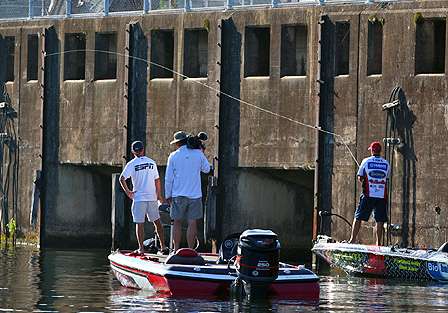
It had to be special: Russ Lane coming from a four-way tie for last place in the Toyota Tundra Bassmaster Angler of the Year standings to within five points of winning the title to start this week's second, and final, event of the postseason on the Alabama River. And, to make it just a little sweeter, he did it on his home waters in front of his family and friends.
Here, in his own words, is how he did it:
Russ Lane
(1st place — 32 pounds, 3 ounces)
This is about as good as it gets. I can't get the picture out of my mind of looking back, over my shoulder, and seeing my friends and former competitors watching me fish, and then hearing the cheers when I landed a fish. Every now and then I could recognize someone's voice. It was special.
My basic pattern for both days was crankbaiting. I threw a Norman DD22, a Bomber Fat Free Shade, a Strike King Pro-model Series 6XD and a Spro Little John in natural, shad colors. The idea was to trigger solid strikes — fairly deep — and mimic the local forage.
At times, if I knew the fish were still there but they had stopped biting the crankbaits, I'd make a few casts with a 3/4-ounce Buckeye Lures Football Jig with a Big Bite Dean Rojas Signature Series Fighting Frog as a trailer (both in green pumpkin). Occasionally, I'd alternate that with a Big Bite Jeff Kriet Signature Series Squirrel Tail Worm in Plum Apple.
Although I didn't use the jig and worm much, they were very important to my total weight. They gave me several key bites that made a big difference in the end — bites I wouldn't have otherwise gotten.
My rods are all American Rodsmiths. For my crankbaits, I used a 7-foot crankbait model but switched to a 7-foot medium-heavy action for my jig and worm. The rod selection was critical. The softer action on the crankbait model helps hook and land bigger bass while the stiffer action gives you more overall control with jigs and plastics.
I mounted Abu Garcia Revo reels to them — a Winch (5.4:1) for the crankbaits and a high-speed model (7.1:1) for the other two baits. I fished my crankbaits with 12-pound-test Berkley Trilene 100% Fluorocarbon and used 17-pound test for the jig and worm.
My knowledge of the lake helped me, but not in the way you might think. All my spots were new. I'd never fished any of them before. The specific physical knowledge I have of the lake wasn't all that important.
What was important was my knowledge of how the fish reacted to specific conditions. In the mornings, they weren't pulling water, so I knew I should be fishing for a big bite in deeper water on the south end of the lake.
But once they turned on the water at the dam, I moved up into the Coosa River and cranked ledges in 15 feet of water where I knew I could get numbers. My knowledge of how they react to the current was invaluable when it came to bait selection and my angle of presentation. I also knew to throw repeatedly to every target. That's a common tactic up in the river.
If there's a lesson for all of us here; it's to never give up. After I lost my rod and reel to that big bass, I didn't get another bite for over an hour. (If you haven't seen the video you should. It's worth a look. I'll never live it down.)
A couple of years ago, I'd have panicked after that, but because of my experience on the Elite Series I knew to keep my head down and keep fishing. You can win a tournament on five casts. Never forget that.
